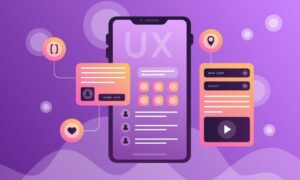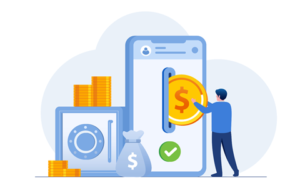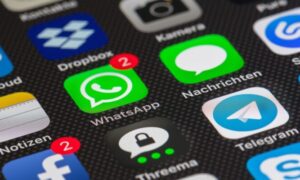Are you tired of pouring countless hours into developing an amazing mobile app, only to see little to no return on your investment? Are you wondering how to take your app to the next level and start generating some serious revenue? Look no further! In this blog post, we will explore the top strategies and tips for monetizing your mobile app and maximizing your revenue. From in-app purchases to subscription models, we will cover it all. Whether you are a seasoned app developer or just starting out, this post is guaranteed to provide you with valuable insights and actionable steps to take your app from a passion project to a profitable venture. So buckle up and get ready to learn how to turn your app into a money-making machine!
What is a mobile app monetization strategy?
Imagine you’ve poured your heart and soul into building a fantastic mobile app that you’re excited to share with the world. But the question arises: how will you make money from it? That’s where app monetization comes into play.
In the world of mobile apps, monetization is like the secret sauce that transforms a great app into a sustainable business. It’s the art of balancing between providing an amazing user experience and generating steady revenue. Finding the perfect monetization strategy is like a game of trial and error. You have to understand your audience’s needs and preferences, experiment with different approaches, and analyze the results to refine your plan.
8 Best Mobile App Monetization Strategies for 2023
App monetization techniques can be a little tricky at times, but with the right information, you can easily familiarize yourself with the various methods and identify the ones that will suit your brand image. Here are 8 of the most underrated app monetization strategies that have become the talk of the town in 2023!
Unlock the Power of In-App Purchases
Picture this: you’re completely immersed in your favorite gaming app, eager to conquer the next level and unlock new challenges. But wait, to access these coveted levels, you need to pay a fee. Welcome to the world of in-app purchases!
In-app purchases offer users the opportunity to access additional products, features, and services within an app. Whether it’s unlocking new game levels, accessing premium content on a streaming app, or upgrading to an advanced budget management tool on a personal finance app, the possibilities are endless.
But, to make these purchases attractive to users, they must be priced fairly and offer clear value for money. After all, no one wants to spend their hard-earned cash on something that won’t enhance their overall app experience. Beyond pricing, optimizing the in-app purchase process is critical. Imagine trying to navigate through a maze of confusing menus and payment options just to make a simple purchase – not exactly an enjoyable experience, right? That’s why designing an intuitive and user-friendly interface is essential, along with ensuring a secure and efficient payment process.
Let Your App Shine with In-App Advertising
Are you a mobile app developer looking for ways to turn your app into a profitable venture? Look no further! In-app advertising is the key to monetizing your app and boosting your revenue streams.
By placing ads within your app, you can provide users with a free experience while still generating revenue. But it’s not just about slapping ads in your app and calling it a day. The mobile app ad format is incredibly versatile and offers various ad formats to choose from, including banner ads, video ads, native ads, interstitial ads, rewarded ads, and gamified ads.
- Banner ads are a classic app advertisement format, but they can be targeted to users based on their data and preferences. Banner ads are generally very small and overlooked on the mobile screen, which means the advertiser is not getting the reach they paid for.
- Video ads allow for in-stream and out-stream options, enabling you to display engaging video ads within your app.
- Native ads blend seamlessly with your app’s design, mimicking its look and feel, making them less intrusive and more effective. Native ads blend in seamlessly with the application and look like just another post on the user’s feed.
- Interstitial ads are full-screen ads that appear between phases of the user’s app experience. Meanwhile, rewarded ads are designed to reward users for watching ads, which is an excellent way to build user loyalty.
- Gamified ads are a unique format that adds an element of fun to the advertising experience, engaging users and increasing ad performance.
Monetizing Your App: To Charge or Not to Charge?
In the vast and ever-expanding world of mobile apps, charging a fee for users to download your creation might seem like the go-to move. However, before taking the plunge, it’s important to assess whether your app’s content is truly unique and valuable enough to warrant a price tag. After all, in today’s market, savvy users will likely seek out similar apps for free rather than shelling out their hard-earned cash.
Still, for publishers whose apps offer an unparalleled gaming experience or a much-needed utility on smartphones and tablets, charging for the download can prove profitable. But be aware, you’re venturing into a relatively uncharted territory, as only a small fraction of apps are currently sold for download fees. As of March 2021, a whopping 93% of iOS apps and 96.7% of Google Play apps were available to users for free.
Freemium Can Boost Your App Monetization
Freemium is a crafty and ingenious mobile app monetization strategy that offers a tantalizing proposition: give users a free taste of your app’s basic features, while offering more advanced, premium features at a price. It’s like offering a sampler platter of your app’s goodness, tempting users to upgrade for the full feast.
This approach is an effective way to reel in new customers and boost revenue without requiring everyone to pay upfront. It also provides users with an opportunity to experience your app’s functionality and value before making a commitment to purchase. It’s like inviting potential customers to a free trial session of your app, allowing them to try it out for themselves and see what they’re missing.
One common example of the freemium app monetization strategy is offering a free app download but charging a fee within the app to users who want to use the app without being subjected to ads. This approach allows app publishers to monetize non-paying users by giving them the option to upgrade and enjoy an ad-free experience. In other words, it’s a win-win situation where users can use the app for free, but also have the option to upgrade and support the mobile app development.
From Data Collection to Profit
As mobile app usage continues to grow exponentially, app developers have access to an enormous amount of user data. This presents a valuable opportunity for data monetization, a strategy in which developers generate revenue by selling or licensing access to the data collected by their app.
From demographic information to user behavior patterns, the data collected by mobile apps can provide valuable insights for businesses across various industries. App developers can choose to sell this data to third-party companies or license it out for a fee, thereby generating revenue without requiring users to pay directly for the app. However, in order to successfully monetize app data, developers must ensure that they are transparent with users about their data collection and sharing practices. With increasingly strict privacy regulations in place, it is important to prioritize user trust and privacy in all data monetization efforts.
Deep Linking for Easy Navigation
Deep linking is the secret magic wand that unlocks seamless app navigation for your users. It’s like having a personal assistant that knows precisely what your users want and guides them straight to their desired pages.
For gaming apps, deep linking saves users time by taking them straight to the level they want to play, bypassing any unnecessary menus or introductory screens. For news or magazine apps, deep linking ensures users can enjoy the latest articles or trending stories with just one click, without having to search manually for relevant content.
This feature is also helpful for retail apps, where users can save their shopping carts with one-click shopping access, making it easier for them to complete a purchase at their convenience. For busy users with limited time, deep linking is the superhero that saves the day by simplifying tasks, reducing complexity, and enhancing their experience.
Monetize Your App Through User Data
Data monetization is a creative approach to discovering hidden reserves of app revenue. When used correctly, user data can provide valuable insights into users’ behaviors, interests, preferences, and purchase habits.
As an app owner, you can leverage this information to create tailored products, promotions, or personalized experiences that excite your users and drive revenue growth. For instance, an e-commerce app can use your users’ browsing history and purchase data to offer personalized item recommendations, and exclusive promotions that resonate with their interests.
To implement this strategy, create a secure and transparent opt-in mechanism for collecting data, ensuring users can easily understand how this data will be used. This approach builds trust and ensures data privacy, which can help you build long-term relationships with your users.
Build Your Email List to Keep Users Engaged
Building an email list is an essential creative strategy for staying connected with your audience and increasing your app revenue. When users opt-in to receive your communications, you have the opportunity to send them valuable content, updates, and promotions.
To build your list, you can offer users that sign up something valuable in exchange for their email addresses. For instance, an educational app can offer a free e-book or a trial period for premium content. By regularly sending emails to your subscribers, you can remind them of new app updates, product launches, and promotions that can drive engagement and revenue.
Another creative way to leverage your email list is by running referral programs and offering your subscribers incentives to share your app with their friends and family. This word-of-mouth marketing can be hugely beneficial in building brand awareness and user acquisition.
Strategies to Strike Gold!
With the rapid growth of the mobile app industry, monetizing your app has become essential to turn your passion into a profit. But with so many options available, choosing the right monetization strategy can be daunting.
From in-app advertising to subscription-based models and data monetization, there is no one-size-fits-all approach. It is crucial to consider the unique features of your app and the behavior of your target audience to determine the best strategy to generate revenue. Remember to prioritize user experience, transparency, and compliance with privacy regulations when implementing any monetization strategy. A satisfied user is more likely to become a loyal customer and recommend your app to others!



































